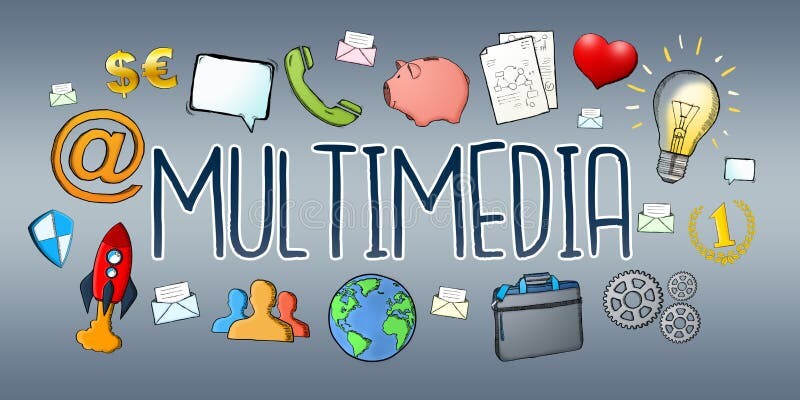
Multimedia in Communication
Definition of Multimedia
Multimedia is a representation of information in an attractive and interactive manner with the use of a combination of text, audio, video, graphics and animation. In other words we can say that Multimedia is a computerized method of presenting information combining textual data, audio, visuals (video), graphics and animations. For examples: E-Mail, Yahoo Messenger, Video Conferencing, and Multimedia Message Service (MMS).
Multimedia as name suggests is the combination of Multi and Media that is many types of media (hardware/software) used for communication of information.
Components of Multimedia
Following are the common components of multimedia:
Text- All multimedia productions contain some amount of text. The text can have various types of fonts and sizes to suit the profession presentation of the multimedia software.
Graphics- Graphics make the multimedia application attractive. In many cases people do not like reading large amount of textual matter on the screen. Therefore, graphics are used more often than text to explain a concept, present background information etc. There are two types of Graphics:
Bitmap images- Bitmap images are real images that can be captured from devices such as digital cameras or scanners. Generally bitmap images are not editable. Bitmap images require a large amount of memory.
Vector Graphics- Vector graphics are drawn on the computer and only require a small amount of memory. These graphics are editable.
Audio- A multimedia application may require the use of speech, music and sound effects. These are called audio or sound element of multimedia. Speech is also a perfect way for teaching. Audio are of analog and digital types. Analog audio or sound refers to the original sound signal. Computer stores the sound in digital form. Therefore, the sound used in multimedia application is digital audio.
Video- The term video refers to the moving picture, accompanied by sound such as a picture in television. Video element of multimedia application gives a lot of information in small duration of time. Digital video is useful in multimedia application for showing real life objects. Video have highest performance demand on the computer memory and on the bandwidth if placed on the internet. Digital video files can be stored like any other files in the computer and the quality of the video can still be maintained. The digital video files can be transferred within a computer network. The digital video clips can be edited easily.
Animation- Animation is a process of making a static image look like it is moving. An animation is just a continuous series of still images that are displayed in a sequence. The animation can be used effectively for attracting attention. Animation also makes a presentation light and attractive. Animation is very popular in multimedia application.
Applications of Multimedia
1. Education
Multimedia plays an vital role in offering an excellent alternative method to traditional teaching by allowing the students to explore and learn various concepts through animation. Students, teachers and the parents enjoy this multimedia mode of learning and multimedia learning materials. Multimedia based teaching and learning system named as MODULO at GMU in Germany developed is a web-based environment that aims to provide students with flexible and decentralized learning environment based on their educational background.
In India, multimedia is used in different ways for teaching and learning like e-learning, distance learning, virtual learning and so on. EDUSAT (Education Satellite) is launched in India for serving the educational sector of the country for emulating virtual classroom in an effective manner.
2. Entertainment
The remarkable advancement in the entertainment industry is due to the Multimedia Technology mainly. This technology is needed in all mode of entertainment like radio, TV, online gaming, video on demand etc.
Video on demand or movies on demand is a service that provides movies to television sets on an individual basis at homes. Movies are stored in a central server and transmitted through a communication network. A set-top box connected to the communication network converts the digital information to analog signals and inputs it to the television set.
3. Business Systems
Business applications for multimedia include presentations, training, internet protocols and so on. The marketing and advertising agencies are using animation techniques for sales promotion. High resolution projectors are common for multimedia presentations on the road. Cell phones and personal digital assistants with Bluetooth and Wi-Fi communication technology makes multimedia communication for business more efficiently.
4. Medical Services
Medical services are grown drastically with the development of multimedia. Medical Students practices surgery methods via simulation prior to actual surgery. Tiny digital cameras are inserted in human body and it displays the inner site of the body through which the medical practitioners can see the internal parts without actually dissecting it.
5. Public Places
Multimedia is available in many public places like trade shows, libraries, railway stations, museums, malls, airports, banks, hotels and exhibitions in the form of kiosks. It helps the customers by providing information to them. The information presented in kiosk are enriched with animation, video, still pictures, graphics, diagrams, maps, audio and text. Banks uses kiosks in the form of ATM machines.
6. Multimedia Conferencing
Multimedia conferencing or video-conferencing is a system that performs face-to-face interactions among participating users, located far from each other, as if they were sitting and discussing in a single room.